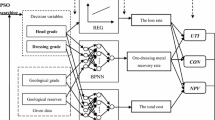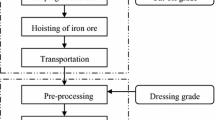Abstract
One of the most important aspects of metal mine design is to determine the optimum cut-off grades and milling grades which relate to the economic efficiency of enterprises and the service life of mines. This paper proposes a hybrid intelligent framework which is based on stochastic simulations and regression, artificial neural network, and genetic algorithms is employed for grade optimization. Firstly, stochastic simulation and regression are used to simulate the uncertainty relations between cut-off grade and the loss rate. Secondly, BP and RBF network are applied to establish two complex relationships from the four variables of cut-off grade, milling grade, geological grade, and recoverable reserves to lost rate and total cost, respectively, in which, BP is used for the one of lost rate, and RBF is for the other. Meanwhile, the real-coding genetic algorithm is performed to search the optimal grades (cut-off grade and milling grade) and the weights of neural networks globally. Finally, the model has been applied to optimize grades of Daye Iron Mine. The results show there are 6. 6978 milling Yuan added compare to unoptimized grades.








Similar content being viewed by others
References
Dagdelen K (1992) Cutoff grade optimization. In: Proceedings of the 23rd international symposium on application of computers and operations research in minerals industry, pp 157–165
Dagdelen K (1993) An NPV optimization algorithm for open pit mine design. In: Proceedings of the 24th international symposium on application of computers and operations research in minerals industry, pp 257–263
Lane KF (1988) The economic definition of ore, cut-off grades in theory and practice, 1st edn. Mining Journal Books Limited, London
Dagbert M (1987) Cut-off grades: statistical estimation and reality. CIM Bull 80(898):73–76
Huang GQ, Du ZY (1996) The method of dynamically optimizing cut-off grade and pre-selection grade. Jiangxi Nonferrous Metals 10(4):1–5 (in chinese)
Mishra B (2006) Development of a computer model for determination of cut off grade for metal life rous deposits. J Mines Metals Fuels 54(6–7):147–152
Pan GH, Ming SX, Wang YH et al (2008) Research and application of dynamic optimization method of cut-off grade for ore drawing. Mining Res Development 28(4):6–9 (in chinese)
Asad MW (2007) An optimum cut-off grade policy for open pit mining operations through net present value algorithm considering metal price and cost escalation. Eng Comput 24(7):723–736
Bascetin A (2007) Determination of optimal cut-off grade policy to optimize NPV using a new approach with optimization factor. J S Afr Inst Mining Metall 107(2):87–94
Poniewierski J, MacSporran G, Sheppard I (2003) Optimisation of cut-off grade at mount is a mines Limited’s Enterprise Mine, Australasian institute of mining and metallurgy publication series. In: Proceedings of 12th international symposium on mine planning and equipment selection n1, pp 531–538
Minnitt RCA (2004) Cut-off grade determination for the maximum value of a small wits-type gold mining operation. J S Afr Inst Mining Metallurgy 104(5):277–283
Demicco RV, Klir GJ (2004) Fuzzy logic in geology. Elsevier Academic Press, Amsterdam
Singh V, Srivastava AK, Tiwary DN et al (2007) Neural networks and their applications in lithostrati graphic interpretation of seismic data for reservoir characterization. The Leading Edge 26(10):1244–1260
Vanlaere W, Buffel P, Lagae G et al (2004) Neural networks for assessing the failure load of a construction. J Comput Appl Math 168(1–2):501–508
Yu SW, Zhu KJ, Diao FQ (2008) A dynamic all parameters adaptive BP neural networks model and its application on oil reservoir prediction. Appl Math Comput 195(1):66–75
Whitley D, Starkweather T, Bogart C (1990) Genetic algorithms and neural networks: optimizing connections and connectivity. Parallel Comput 14(3):347–361
Torres M, Hervás C, Amador F (2005) Approximating the sheep milk production curve through the use of artificial neural networks and genetic algorithm. Comput Oper Res 32:2653–2670
Holland JH (1975) Adaptation of natural and artificial system. The university of Michigan Press, Ann Arbor
Shanthi D, Sahoo ZG (2009) Evolving connection weights of artificial neural networks using genetic algorithm with application to the prediction of stroke disease. Int J Soft Comput 4(2):95–102
He Y, Zhu K, Gao S et al (2009) Theory and method of genetic-neural optimizing cut-off grade and grade of crude ore. Expert Systems Applications 36(4):7617–7623
Jian A, Zhao D, Sun H et al (2004) Application of evolutionary neural network in optimization of grade of crude ore into concentration plant. Mining Res Dev 24(4):44–46
Minnitt RCA (2004) Cut-off grade determination for the maximum value of a small Wits-type gold mining operation. J S Afr Inst Min Metall 7:277–284
Yegnanarayana B (1999) Artificial neural networks. Prentice-Hall, New Delhi
Principe JC, Euliano NR, Lefebvre WC (2000) Neural and adaptive systems, fundamentals through simulations. Wiley, New York
Rumelhart DE, Hinton GE, Williams RJ (1986) Learning internal representations by error propagation. In: Rumelhart DE, McClelland JL (eds) Parallel distributed processing: explorations in the microstructure of cognition, vol 1. The MIT Press, Cambridge, pp 318–362
Moody J, Darken C (1989) Faster learning in networks of locally tuned processing units. Neural Comput 1(2):281–294
Er MJ, Wu S, Lu J, Toh HL (2002) Face recognition with radial basis function (RBF) neural networks. Trans Neural Netw 13(3):697–710
Goldberg DE (1998) Genetic algorithms in search, optimisation and machine learning. Addison-Wesley, Reading
Gupta RK, Bhunia AK, Roy D (2009) A GA based penalty function technique for solving constrained redundancy allocation problem of series system with interval valued reliability of components. J Comput Appl Math 232(2):275–284
Kristinsson K, Dumont GA (1992) System identification and control using genetic algorithm. IEEE Trans Syst Man Cybern 22(5):1033–1046
Nan J, Zhiye Z, Liqun R (2003) Design of structural modular neural networks with genetic algorithm. Adv Eng Softw 34(1):17–24
Ballester PJ, Carter JN (2003) Real-parameter genetic algorithms for finding multiple optimal solutions in multi-modal optimization. In: Cantupaz E et al. (eds) Proceedings of 5th annual genetic and evolutionary computation conference (GECCO 2003). Springer, Berlin, pp 706–717
Herrera F, Lozano M, Sánchez AM (2005) Hybrid crossover operators for real-coded genetic algorithms: an experimental study. Soft Comput 9(4):280–298
Deb K, Beyer H (2001) Self-adaptive genetic algorithms with simulated binary crossover. Evolutionary Computation 9(2):197–221
Rajendra M, Jena PC, Raheman H (2009) Prediction of optimized pretreatment process parameters for biodiesel production using ANN and GA. Fuel 88(5):868–875
McAdams HH, Arkin A (1998) Simulation of prokaryotic genetic circuits. Ann Rev Biophy Biomol Struc 27:99–224
Miura S, Shimokawa T, Nomuraa T (2008) Stochastic simulations on a model of circadian rhythm generation. BioSystems 93(1–2):133–140
Kohlmorgen U, Schmeck H, Haase K (1999) Experiences with fin-grainedparallel genetic algorithms. Ann Oper Res 90:203–219
Srinivas M, Patnaik LM (1994) Adaptive probabilities of crossover and mutation in genetic algorithms. IEEE Trans Syst Man Cybern 24(4):656–667
Acknowledgments
This research was fully supported by National Natural Science Foundation Grant No. 70573101 of the People’s Republic of China and Wuhan iron and steel (group) corp. the Research Foundation Outstanding Young Teachers, China University of Geosciences(Wuhan)CUGQNW0901, and the Special Fund for Basic Scientific Research of Central Colleges, China University of Geosciences(Wuhan).
Author information
Authors and Affiliations
Corresponding author
Rights and permissions
About this article
Cite this article
Yu, S., Zhu, K. & He, Y. A hybrid intelligent optimization method for multiple metal grades optimization. Neural Comput & Applic 21, 1391–1402 (2012). https://doi.org/10.1007/s00521-011-0593-7
Received:
Accepted:
Published:
Issue Date:
DOI: https://doi.org/10.1007/s00521-011-0593-7




